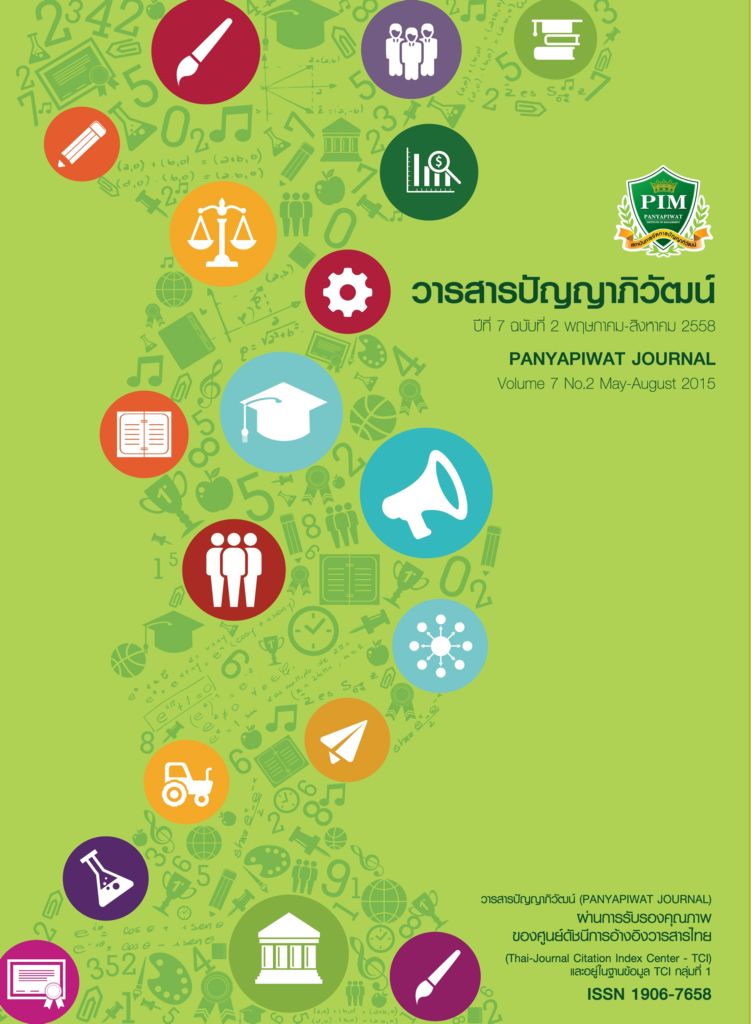การออกแบบระบบการจัดการผลการปฏิบัติงาน กรณีศึกษา รัฐวิสาหกิจสาขาพลังงานแห่งหน่ง
Main Article Content
บทคัดย่อ
บทคัดย่อ
รัฐวิสาหกิจประเภทพลังงานเป็นรัฐวิสาหกิจที่จัดตั้งโดยพระราชบัญญัติ เพื่อดำเนินการด้านการผลิตและ
จำหน่ายพลังงาน กำกับดูแลโดย สำนักงานคณะกรรมการพัฒนาการเศรษฐกิจและสังคมแห่งชาติ (สศช.) สำนักงานคณะกรรมการนโยบายรัฐวิสาหกิจ (สคร.) กระทรวงการคลัง และกระทรวงมหาดไทย เพื่อให้บรรลุตัวแปรและเป้าหมายในการดำเนินการ รัฐวิสาหกิจประเภทพลังงานแห่งนี้จำเป็นต้องมีการพัฒนาระบบการจัดการผลการปฏิบัติงานที่เชื่อมโยงสู่การปฏิบัติ และเชื่อมโยงกับระบบการบริหารทรัพยากรมนุษย์อื่น โครงการวิจัยนี้มีวัตถุประสงค์เพื่อออกแบบระบบการจัดการผลการปฏิบัติงานของรัฐวิสาหกิจประเภทพลังงานให้มีประสิทธิภาพเป็นไปตามมาตรฐานของแนวปฏิบัติที่ดี (Best Practice) ผลการศึกษาพบว่า การออกแบบระบบการจัดการผลการปฏิบัติผลงานต้องมี 6 ประการ คือ (1) การวางแผนเพื่อการจัดการผลการปฏิบัติงาน (2) การสร้างการมีส่วนร่วมในการขับเคลื่อนระบบการจัดการผลการปฏิบัติงาน (3) การสื่อสารเพื่อสร้างความเข้าใจ (4) การบริหารผลการปฏิบัติงานและปรับปรุงงาน (5) การประเมินและทบทวนผลการปฏิบัติงาน และ (6) การบูรณาการระบบการจัดการผลการปฏิบัติงานกับระบบการบริหารทรัพยากรมนุษย์อื่น ข้อค้นพบจากการวิจัยนี้มีประโยชน์นำไปใช้ในการนำระบบไปทดลองปฏิบัติ ตั้งแต่การวางแผนเพื่อการจัดการผลการปฏิบัติงาน การดำเนินการตามระบบที่ได้วางไว้ มีการประเมินและทบทวนผลการปฏิบัติงาน การรวบรวมผลการปฏิบัติงาน และการเชื่อมโยงบูรณาการกับระบบการบริหารทรัพยากรมนุษย์อื่น
Abstract
A state enterprise in the power sector is an organization established by the Act to carry out the production and distribution of energy governed by State Enterprise Policy Office (SEPO), Ministry of finance. In order to conform with SEPO’s policy, the organization has set its vision, mission and strategic issues. For achieving the organizational goals, the organization needs to develop a performance management system. This research aims to design a performance management system of a state enterprise in the power sector to run effectively and meet the standards of best practice.
The results indicate that the design of performance management system requires 6 steps: (1) performance management planning (2) participatory creation and development to drive performance management system (3) communication for raising awareness and understanding (4) performance management and improvement (5) performance evaluation and review and (6) the integration of performance management systems and related human resource management systems.
The findings from this research are useful to apply the system into practice in various ways, from planning for management performance, implementing planned system, evaluating and reviewing performance, gathering performance to integrating with other related human resource management systems.
Article Details
“ข้าพเจ้าและผู้เขียนร่วม (ถ้ามี) ขอรับรองว่า บทความที่เสนอมานี้ยังไม่เคยได้รับการตีพิมพ์และไม่ได้อยู่ระหว่างกระบวนการพิจารณาลงตีพิมพ์ในวารสารหรือแหล่งเผยแพร่อื่นใด ข้าพเจ้าและผู้เขียนร่วมยอมรับหลักเกณฑ์การพิจารณาต้นฉบับ ทั้งยินยอมให้กองบรรณาธิการมีสิทธิ์พิจารณาและตรวจแก้ต้นฉบับได้ตามที่เห็นสมควร พร้อมนี้ขอมอบลิขสิทธิ์บทความที่ได้รับการตีพิมพ์ให้แก่สถาบันการจัดการปัญญาภิวัฒน์หากมีการฟ้องร้องเรื่องการละเมิดลิขสิทธิ์เกี่ยวกับภาพ กราฟ ข้อความส่วนใดส่วนหนึ่งและ/หรือข้อคิดเห็นที่ปรากฏในบทความข้าพเจ้าและผู้เขียนร่วมยินยอมรับผิดชอบแต่เพียงฝ่ายเดียว”
เอกสารอ้างอิง
นันทวัฒน์ บรมานนท์. (2551). ครั้งที่ 7 รัฐวิสาหกิจ องค์การมหาชนและหน่วยบริการรูปแบบพิเศษ. สืบค้นเมื่อ 26 ธันวาคม 2557, จาก http://www.pub-law.net/publaw/view.aspx?id=1241
ปิยะชัย จันทรวงศ์ไพศาล. (2551). กํารบริหํารผลงําน ทำจริง...ทำอย่ํางไร?. กรุงเทพฯ: เอช อาร์ เซ็นเตอร์.
ผุสดี รุมาคม. (2551). การประเมินการปฏิบัติงานฉบับปรับปรุงแก้ไข. พิมพ์ครั้งที่ 3. กรุงเทพฯ: ธนาเพรส.
พระราชบัญญัติคุณสมบัติมาตรฐานสำหรับกรรมการและพนักงานรัฐวิสาหกิจ พ.ศ. 2518. (2518). ราชกิจจานุเบกษา, เล่ม 92, ตอนที่ 16 ฉบับพิเศษ, 2-3.พระราชบัญญัติสภาพัฒนาการเศรษฐกิจแห่งชาติ พ.ศ. 2502. (2502). ราชกิจจานุเบกษา, เล่ม 76, ตอนที่ 69, 2.
สำนักงานคณะกรรมการนโยบายรัฐวิสาหกิจ. (2553). หลักการระบบประเมินผลการดำเนินงานรัฐวิสาหกิจ. สืบค้นเมื่อ 12 มกราคม 2558, จาก http://www.sepo.go.th/2011-06-07-09-19-39/2011-07-24-05-34-03.htm
อลงกรณ์ มีสุทธา และสมิต สัชฌุกร. (2551). การประเมินผลกํารปฏิบัติงาน (ฉบับปรับปรุง). กรุงเทพฯ: สมาคมส่งเสริมเทคโนโลยี (ไทย-ญี่ปุ่น).American National Standards Institute. (2012). Performance Management Programs. Retrieved January 12, 2015, from https://www.shrm.org/hrstandards/documents/performance%20management%20ans%20%282012%29.pdf
Baird, K., Schoch, H. & Chen, Q. (2012). Performance management system effectiveness in Australian local government. Pacific Accounting Review, 24(2), 161-185.
Cheng, M. I., Dainty, A. & Moore, D. (2006). Implementing a new performance management system within a project-based organization: A case study. International Journal of Productivity and Performance Management, 56(1), 60-75.
Franceschini, F., Galetto, M. & Turina, E. (2013). Techniques for impact evaluation of performance measurement systems. International Journal of Quality & Reliability Management, 30(2), 197-220.
James, W. (2009). Rationality, institutionalism and accounting change: understanding a performance management system within an Australian public sector entity. Journal of Accounting & Organizational Change, 5(3), 362-389.
KeongChoong, K. (2013). Are PMS meeting the measurement needs of BPM?. A literature review. Business Process Management Journal, 19(3), 535-574.
Longo, M. & Mura, M. (2008). Stakeholder management and human resources: development and implementation of a performance measurement system. Corporate Governance: The international journal of business in society, 8(2), 191-213.
Metz, E. J. (2000). Using strategic design concepts to create a best-in-class performance management system. National Productivity Review, 19(2), 51-62.
Norhayati, M. A. & Siti-Nabiha, A. K. (2009). A case study of the performance management system in a Malaysian government linked company. Journal of Accounting & Organizational Change, 5(2), 243-276.
Schoonover, C. S. (2011). Performance Management Best Practices: Part One, Program Design. Retrieved January 17, 2015, from http://www.inspireone.in/pdf/Performance/Performance-Management-Best-Practices.pdf
Tung, A., Baird, K. & Schoch, H. P. (2011). Factors influencing the effectiveness of performance measurement systems. International Journal of Operations & Production Management, 31(12), 1287-1310.
Translated Thai References
Boramanon, N. (2008). Public enterprise, public organization and service delivery unit. Retrieved December 26, 2014, from http://www.pub-law.net/publaw/view.aspx?id=1241 [in Thai]
Chantarawongpaisarn, P. (2008). Performance management... how to?. Bangkok: HR Center. [in Thai]
Meesuttha, A. & Sachukorn, S. (2008). Performance evaluation (revised ed.). Bangkok: Technology Promotion Association (Thailand-Japan). [in Thai]
National economic and social development board act. (1959). Government gazette, 76, 2. [in Thai]
Qualification Standard for state enterprise’s committee and employee act. (1975). Government gazette, 92, 2-3. [in Thai]
Rumakhom, P. (2008). Performance evaluation. (revised ed.). Bangkok: Thana press. [in Thai]
State enterprise policy office. (2010). Principle of performance management system for state enterprise. Retrieved January 12, 2015, from http://www.sepo.go.th/2011-06-07-09-19-39/2011-07-24-05-34-03.htm [in Thai]


